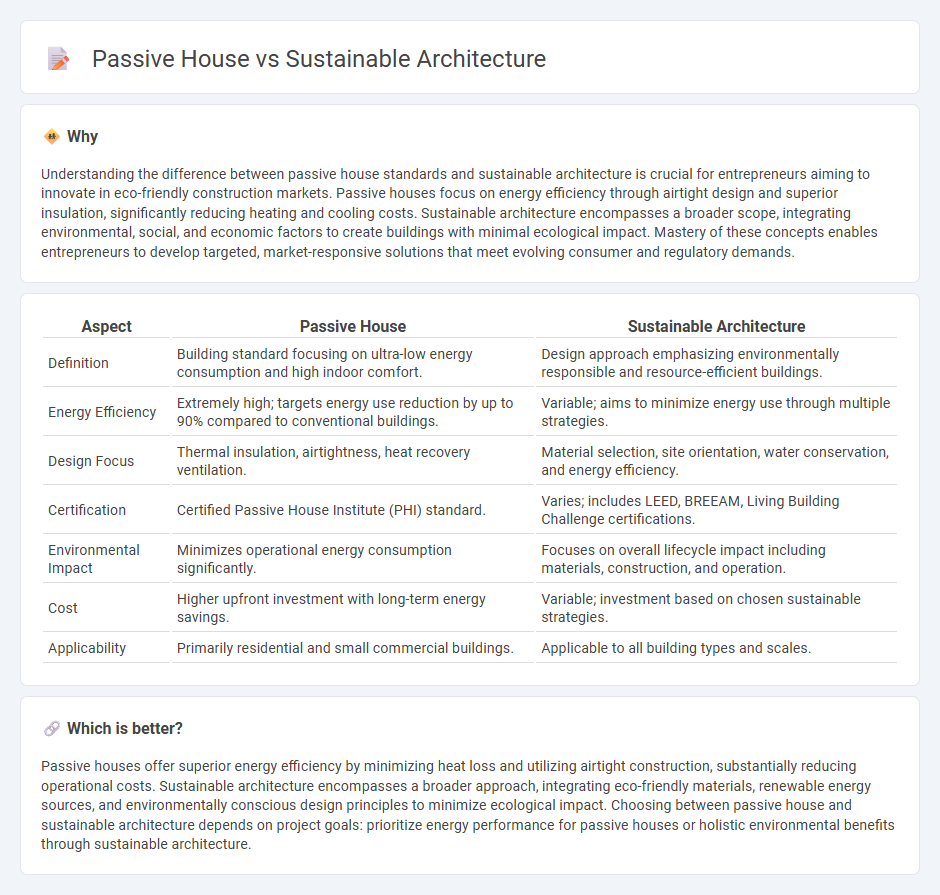
Entrepreneurship in passive house design drives innovation in energy-efficient building practices, significantly reducing heating and cooling demands compared to traditional methods. Sustainable architecture integrates eco-friendly materials and renewable energy solutions to minimize environmental impact while promoting occupant well-being. Discover how these approaches transform green building opportunities and market potential.
Why it is important
Understanding the difference between passive house standards and sustainable architecture is crucial for entrepreneurs aiming to innovate in eco-friendly construction markets. Passive houses focus on energy efficiency through airtight design and superior insulation, significantly reducing heating and cooling costs. Sustainable architecture encompasses a broader scope, integrating environmental, social, and economic factors to create buildings with minimal ecological impact. Mastery of these concepts enables entrepreneurs to develop targeted, market-responsive solutions that meet evolving consumer and regulatory demands.
Comparison Table
| Aspect | Passive House | Sustainable Architecture |
|---|---|---|
| Definition | Building standard focusing on ultra-low energy consumption and high indoor comfort. | Design approach emphasizing environmentally responsible and resource-efficient buildings. |
| Energy Efficiency | Extremely high; targets energy use reduction by up to 90% compared to conventional buildings. | Variable; aims to minimize energy use through multiple strategies. |
| Design Focus | Thermal insulation, airtightness, heat recovery ventilation. | Material selection, site orientation, water conservation, and energy efficiency. |
| Certification | Certified Passive House Institute (PHI) standard. | Varies; includes LEED, BREEAM, Living Building Challenge certifications. |
| Environmental Impact | Minimizes operational energy consumption significantly. | Focuses on overall lifecycle impact including materials, construction, and operation. |
| Cost | Higher upfront investment with long-term energy savings. | Variable; investment based on chosen sustainable strategies. |
| Applicability | Primarily residential and small commercial buildings. | Applicable to all building types and scales. |
Which is better?
Passive houses offer superior energy efficiency by minimizing heat loss and utilizing airtight construction, substantially reducing operational costs. Sustainable architecture encompasses a broader approach, integrating eco-friendly materials, renewable energy sources, and environmentally conscious design principles to minimize ecological impact. Choosing between passive house and sustainable architecture depends on project goals: prioritize energy performance for passive houses or holistic environmental benefits through sustainable architecture.
Connection
Entrepreneurship in the realm of sustainable architecture drives innovation in passive house design by promoting energy-efficient building techniques that minimize environmental impact. Startups and businesses focus on integrating renewable materials, advanced insulation, and smart energy systems to create cost-effective, eco-friendly housing solutions. This synergy fosters market growth while addressing climate change through scalable, sustainable construction practices.
Key Terms
Energy Efficiency
Sustainable architecture integrates energy-efficient design principles, renewable materials, and environmental harmony to minimize its ecological footprint, while passive house standards prioritize rigorous insulation, airtight construction, and optimized thermal performance to achieve ultra-low energy consumption. Passive houses reduce heating and cooling needs by up to 90%, making them a benchmark for energy efficiency within sustainable building practices. Explore in-depth comparisons and energy-saving strategies to enhance your sustainable building projects.
Lifecycle Assessment
Sustainable architecture emphasizes eco-friendly design principles, materials, and construction processes to minimize environmental impact throughout a building's lifecycle, while passive house standards specifically target extreme energy efficiency and indoor comfort using airtight construction and mechanical ventilation. Lifecycle Assessment (LCA) evaluates both approaches by measuring carbon footprint, energy consumption, and resource use from material extraction to end-of-life, highlighting passive houses' advantages in operational energy savings despite potentially higher initial embodied energy. Explore detailed LCA studies to understand the comparative benefits and choose the optimal path for green building projects.
Thermal Envelope
Sustainable architecture emphasizes energy efficiency and eco-friendly materials, with the thermal envelope playing a crucial role in minimizing heat loss and gain to optimize indoor comfort. Passive House standards demand rigorous airtightness, high insulation levels, and advanced window technology within the thermal envelope to reduce heating and cooling needs drastically, ensuring ultra-low energy consumption. Explore deeper insights into thermal envelope innovations and their impact on sustainable building performance.
Source and External Links
Sustainable architecture - Wikipedia - Sustainable architecture minimizes negative environmental impacts through efficient use of materials, energy, and space, emphasizing energy efficiency with passive and active techniques and renewable energy integration throughout a building's life cycle.
What is Sustainable Architecture - Barker Associates - Sustainable architecture designs healthy living environments that reduce environmental impacts and energy use, focusing on long-term resource efficiency and benefits like biodiversity protection, cost reduction, and improved inhabitant well-being.
The future of zero waste living: sustainable architecture - Sustainable architecture promotes recycled or earth-friendly materials and renewable energy use to reduce environmental impact and operational costs, combining ecological benefits with aesthetically pleasing, nature-inspired designs.
 dowidth.com
dowidth.com